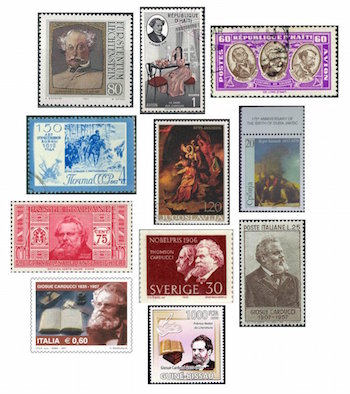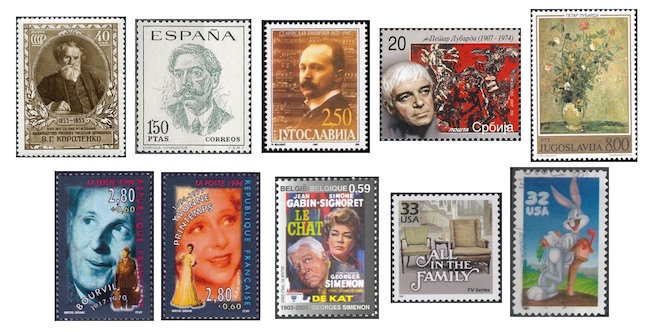The Arts on Stamps of the World — July 27
An Arts Fuse regular feature: the arts on stamps of the world.

By Doug Briscoe
We celebrate three Yugoslavs today, touching on literature, painting, and music, and three figures from French cinema, along with Italian poet Giosuè Carducci, Spanish composer Enrique Granados, TV producer Norman Lear, and a few more.
But we begin, as promised three days ago, with Alexandre Dumas, fils (27 July 1824 – 27 November 1895), whose birthday fell three days after that of his father. He was the product of one of that gentleman’s many affairs, this one with a dressmaker named Marie-Laure-Catherine Labay. Legally recognized in 1831, young Dumas was given a sound education and went on to become not only more famous than AD père (during his lifetime) but the leading French playwright of the age. (Nowadays the father has the greater claim to fame with The Count of Monto Cristo and The Three Musketeers.) AD fils wrote mostly novels in the 1840s and ‘50s and mostly plays thereafter. His most famous work, La Dame aux camélias began as a novel (1848) before being turned into a play (1852), which, in turn, was made into an opera, La traviata, by Verdi in 1853. (The Lady of the Camellias will feature in the story of another of today’s birthday people a bit further down the page.) We see Dumas on a stamp of Liechtenstein and on two from Haiti, the origin of his Afro-Caribbean great-grandmother.
Denis Davydov (27 July [O.S. 16 July] 1784 – 4 May [O.S. 22 April] 1839) was a Russian soldier of the Napoleonic era who wrote earthy poems celebrating the life of the hussar. He was the model of the brave, handsome, devil-may-care, hard-drinking, whoring cavalryman, but he also wrote some valuable memoirs and reflections on the military life of the day. The stamp shows him leading partisans in his fight against Napoleon on the 150th anniversary of the ill-fated French invasion of Russia.
Georgije “Ðura” Jakšić (27 July 1832 – 16 November 1878) excelled as both a poet and a painter, in addition to which he wrote three full-length plays and about forty short stories. A Serbian nationalist, he took part in the revolution of 1848, which interrupted his education, as well as in an uprising against the Turks decades later. Jakšić was driven also by ideals of personal freedom, morality, and the striving for the perfection of human nature. The stamps, one Yugoslavian from 1976, one Serbian from 2007, give us his pictures Montenegrins’ Rebellion (1862) and Night Watch (1876-78).
Giosuè Carducci (27 July 1835 – 16 February 1907) was the first Italian to receive the Nobel Prize in Literature, and this he achieved at the age of 70. His reputation lies in poetry, but he was also a prolific writer of prose (literary criticism, biographies, essays) and a translator who made Italian versions of Goethe and Heine and the 9th book of the Iliad. A classicist, a social critic, and an outspoken atheist, he wrote a vehemently anticlerical poem called “Hymn to Satan” in 1863 that caused quite a stir with its publication some years later. His best works, though, were written in his later years, in particular the collections Rime Nuove (New Rhymes, 1861-87) and Odi Barbare (Barbarian Odes, 1873-89). He also served as a senator and is held by some to be modern Italy’s national poet.
Vladimir Korolenko (27 July 1853 – 25 December 1921) was a Russian journalist and short story writer of Ukrainian, Cossack, and Polish ancestry. Though his first language was Polish, and he was strongly influenced by Ukrainian folklore, he gravitated toward Russian literature. A fierce critic of the Tsarist system (and later of the Bolsheviks), Korolenko was thrice exiled for various “offenses”, though the experiences did give him a wealth of material he mined in his later writings. He managed to get pieces published and saw his first collection into print in 1886. The stories enjoyed much popularity and were translated into English quite early on. He turned to journalism the next year and was vigorous and tireless not only as a writer but as a hands-on activist for human rights. He welcomed the Revolution but deplored the cruelties of the civil war and soon condemned Bolshevism’s despotic tendencies. Effusively admired by Chekhov and Tolstoy, he was a mentor to Gorky and Konstantin Balmont.

July 27 is also the birthday of Spanish composer Enrique Granados (1867 – 24 March 1916). Probably his best known work is the expansive piano collection Goyescas, inspired by the art of Goya. After composing these pieces in 1911, he went on to write an opera on the subject, which had its première in New York in 1916. He stayed on to give a recital at the request of Woodrow Wilson and, before leaving New York, also made some piano rolls, which still exist. As a result of the delay in his departure, he boarded the passenger ferry SS Sussex, which tragically was torpedoed by a German U-boat. Granados was one of the 50-100 people who perished. He drowned after leaping from his lifeboat to rescue his wife, who died with him. Ironically, the ship broke in two, and the part that contained his cabin remained afloat and was even successfully towed to port. The doomed ship was repaired and sold to Greece in 1919, but was scrapped following a fire just two years later.
The Serbian composer and conductor Stanislav Binički (27 July 1872 – 15 February 1942), who studied with Rheinberger, became the first director of opera at the National Theatre in Belgrade in 1889. He worked with the Belgrade Military Orchestra from 1899 until the group lost all its instruments and music archive during World War I. In the meantime, Binički had composed the first Serbian opera, At Dawn (1903). He conducted the first performances in Serbia of Beethoven’s 9th and Haydn’s Creation and shortly thereafter founded the second Serbian Music School (1911). When war broke out, Binički joined the army and after its victory in the Battle of Cer wrote March to Victory, later renamed March on the Drina, which achieved great popularity and remains one of his best known pieces. After the fall of Belgrade in 1915, he went to Corfu, where he gathered new instruments and scores and gave a concert in the island’s National Theatre, going on to tour France in 1917. His other compositions include incidental music for plays, sacred works, and many other marches and shorter pieces.
The Montenegrin painter Petar Lubarda (27 July 1907 – 13 February 1974) studied in Belgrade and Paris and held exhibitions in the latter city in 1927 and in Rome in 1929. He was particularly interested in depicting scenes from the history and mythology of Serbia and Montenegro, espcially the 1389 Battle of Kosovo between the Serbs and the Ottomans, which Lubarda rendered some thirty times. The newer Serbian stamp, showing one version of his Konji (Horses, 1953) is more representative of his style than the old Yugoslavian one of the still life, which I assume must be one of his earlier works.
Today is the one hundredth anniversary of the birth of André Robert Raimbourg, who was born posthumously, his father having fallen in World War I. The child grew up in the town of Bourville, from which he took his stage name André Bourvil, shortened, as is the tradition among French film comedians, to the single name Bourvil. He acted and sang in a great many films between 1942 and 1971, occasionally taking a dramatic turn, but often playing relatively passive comic characters opposite more domineering types, such as those played by his colleague Louis de Funès, whose birthday is coming up next week. Bourvil also took part in the 1948 André Cluytens recording of Offenbach’s Tales of Hoffmann. Bourvil died of a form of myeloma at age 53 on 23 September 1970. One of his films, Royal Affairs in Versailles (1954), was directed by Sacha Guitry, who happens to have been the husband of our next subject.

I just now discovered that Tuesday was the birthday of French singer and actress Yvonne Printemps (25 July 1894 – 19 January 1977), so I thought I’d include her today, belatedly. (I hate when that happens.) It was the coincidence of her appearance among the same set of stamps as Bourvil that tipped me off. (I’m saving another odd coincidence for the end of this paragraph.) Her birth name was Yvonne Wigniolle (the spelling varies), and in spite of her bourgeois background she struck out for the stage at the tender age of twelve. The next year she was dancing at the Folies Bergère, where her colleagues dubbed her “Printemps”. In one of her performances she mimicked Sacha Guitry, whose wife saw the show and brought him along to see it. Big mistake. He cast her in one of his own revues and, four years later, married her. In 1925 she was cast in the title role (a pants role) of Guitry’s musical Mozart. Their marriage ended in 1932, and Printemps formed a long liaison, both personal and professional, with the French actor Pierre Fresnay. The couple are buried together in Neuilly-sur-Seine. Printemps had an arresting voice and was often cited for her remarkable breath control. She also appeared in about ten films between 1918 and 1951. Now, speaking of wild coincidences, one of those films, in which Printemps played the lead, happens to have been a version (from 1934, directed by Abel Gance) of La Dame aux camélias!
Our third consecutive figure from French cinema is the director Pierre Granier-Deferre (27 July 1927 – 16 November 2007), who began directing in 1962 and worked with many of his country’s biggest stars: Jean Gabin, Simone Signoret, Yves Montand, Charles Aznavour, Alain Delon, Philippe Noiret, Jean-Louis Trintignant, Romy Schneider, Lino Ventura, and more. With Gabin and Signoret he made Le Chat in 1971, as recalled on the Belgian stamp of 2003.
Happy birthday to writer and producer Norman Lear (born July 27, 1922), the creator of All in the Family, among numerous other TV shows, and also founded the politically progressive advocacy organization People for the American Way in 1981. All in the Family was enough of a phenomenon to be deemed a landmark of the 1970s, so when in 1998-2000 the USPS issued several sheets of stamps looking back over the 20th century, the show was chosen along with such other distinctive features of that decade as the bicentennial, Big Bird, Secretariat, and disco music. (Interestingly enough, Sally Struthers’s birthday is tomorrow.)
It was on this date in 1940 that the animated short A Wild Hare was released, so happy 77th birthday to Bugs Bunny.
A graduate of the University of Massachusetts with a B.A. in English, Doug Briscoe worked in Boston classical music radio, at WCRB, WGBH, and WBUR, for about 25 years, beginning in 1977. He has the curious distinction of having succeeded Robert J. Lurtsema twice, first as host of WGBH’s weekday morning classical music program in 1993, then as host of the weekend program when Robert J.’s health failed in 2000. Doug also wrote liner notes for several of the late Gunther Schuller’s GM Recordings releases as well as program notes for the Boston Classical Orchestra. For the past few years he’s been posting a Facebook “blog” of classical music on stamps of the world, which has now been expanded to encompass all the arts for The Arts Fuse.
